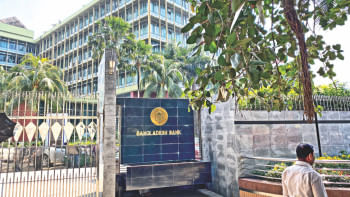Double delight for Aman growers

Thanks to a favourable monsoon and buoyant prices that Aman growers across the country get a reason to rejoice after a rather unhappy ending of Boro season.
With over 80 percent paddy already harvested, the Department of Agriculture Extension (DAE) and the UN Food and Agriculture Organisation have projected a bumper Aman output -- 13.6 million tonnes -- marginally surpassing last year's record high of 13.5 million tonnes.
The prices are also good, which market sources attribute to the government intervention through imposing tariff on cheap rice imports from India and to the high demand for both coarse and fine varieties with old stocks exhausting fast.
Last time growers reduced the acreage of Boro rice in fear of low prices in the market.
Highly input-intensive irrigated winter rice -- Boro -- accounts for 55 percent of Bangladesh's annual staple output while Aman, mostly fed by monsoon rains, accounts for 38 percent of yearly rice output. The rest comes from Aus, a season still dominated by low-output indigenous varieties. "We have got a very good Aman production this season. And the current price offered for paddy in the market is better than what we got in the last Aman season," said Abdul Jalil, a farmer from Naogaon's Niamatpur on phone.
Jalil, who grew coarse varieties of Aman on more than 3.5 acres of land and finer varieties on another one acre, not only spoke for him. He confirmed that other growers in the district also had good production to the tune of 65 maunds an acre on average.
Coarse rice is selling at up to Tk 750 a maund, he said, which is quite high a price compared to Tk 550-600 during the last Aman season.
Farmer Entazul Haque, of Baliadangi in Thakurgaon, said Aman production in Thakurgaon is also good and the prices encouraging.
For each sack of 80-kg coarse rice, farmers are offered up to Tk1600, which was Tk 1200-1300 in the last season.
Abdul Majid Bablu, a trader in Kushtia's Khajanagor, keeps track of trends in the rice market.
He said Aman paddy supplies to the mills and wholesalers of Khajanagor have been good and the prices are good too in comparison to those of last Boro season as well as last year's Aman season.
Khajanagor boasts one of the biggest rice markets in the country, known for its supply of, among other varieties, Miniket (originally 'mini-kit') most consumed in Dhaka.
A bumper Aman production cheered growers who did reduce Boro acreage earlier for low prices but bounced back by growing Aman on higher acreage and eventually reaped the benefit.
An initial Bangladesh Bureau of Statistics (BBS) estimates showed 1.38 percent fall in Boro acreage to 4.77 million hectares in the Boro season ending in May this year. On the other hand, as per the preliminary data of the DAE, this season's Aman acreage was upped by two percent to 5.69 million hectares, which made significant contribution to the higher Aman output.
Meantime, to support Aman growers the government last week announced procurement of 0.3 million tonnes of rice at a premium rate of Tk 33 a kg, two taka more than the price it offered in the last year's Aman season.
According to the BBS estimation, Aman production grew steadily year-on-year basis -- 12.8 million tonnes in fiscal 2011-12 to 13.2 million tonnes in fiscal 2013-14 and 2014-15 and 13.5 million tonnes in last fiscal.
Experts say any further rapid growth will only be possible if breeders put efforts in developing high-yield Aman varieties with the same zeal that they did for Boro.


 For all latest news, follow The Daily Star's Google News channel.
For all latest news, follow The Daily Star's Google News channel. 



Comments